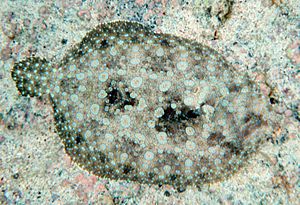Microcotyle bothi facts for kids
Quick facts for kids Microcotyle bothi |
|
|---|---|
| Scientific classification | |
| Genus: |
Microcotyle
|
| Species: |
bothi
|
Microcotyle bothi is a tiny, worm-like creature. It is a type of monogenean, which means it's a parasite that lives on fish. This specific parasite makes its home on the gills of marine fish. Scientists first found it in Hawaii. It belongs to a family of parasites called Microcotylidae.
What Does Microcotyle bothi Look Like?
Microcotyle bothi has a flat body, much like other worms in its group. It is quite small, usually between 3.8 and 7.9 millimeters long. That's less than a centimeter!
Its body has two main parts. The front part holds most of its important organs. The back part is called a haptor. This haptor is special because it helps the parasite hold on tight. It has 45 to 65 tiny gripping tools called clamps. These clamps are arranged in two rows, one on each side of the haptor. They are what allow the parasite to attach itself firmly to the fish's gill.
At the very front of its body, Microcotyle bothi also has two small suckers. These are called buccal suckers.
Inside its body, it has a simple digestive system. It has a mouth at the front, a strong, muscular tube called a pharynx, and an intestine. The intestine has two branches that go along the sides of its body. Like many parasites, each adult Microcotyle bothi has both male and female reproductive organs.
Where Does Microcotyle bothi Live?

The main fish that Microcotyle bothi lives on is called the flowery flounder, or Bothus mancus. This is known as its "type-host."
Scientists first discovered this parasite off the coast of Hawaii. This place is called its "type-locality."
A scientist named Satyu Yamaguti also found two other types of Microcotyle parasites in Hawaii. These were Microcotyle polymixiae and Microcotyle emmelichthyops. They were found on different kinds of fish.

